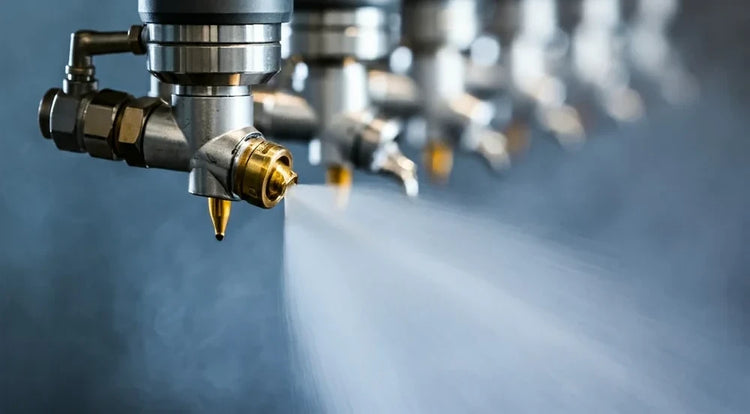To view pricing, please fill the form added below.
Already have an account? Please Login here.Gas Cooling Nozzles Built for Performance
Precision spray cooling for power generation, refineries, and industrial facilities. Maximize efficiency while reducing operating costs and environmental impact.
Why Gas Cooling Matters in Industrial Operations
Gas cooling is essential for managing extreme process conditions. From NOx emissions control to temperature regulation in power turbines, precise spray cooling ensures optimal equipment performance while meeting environmental compliance standards.
Energy Efficiency
Reduce compressed air consumption and energy usage with ultra-fine atomization technology. Our nozzles achieve cooling targets with minimal resource input.
Environmental Compliance
Meet NOx, SO₂, and other emission control requirements with precision cooling. Advanced drop size control ensures effective cooling without overspray.
Equipment Protection
Prevent thermal stress on critical equipment. Strategic nozzle placement and precise droplet control extend component life and reduce maintenance costs.
Superior Atomization Technology
Our gas cooling nozzles produce exceptionally fine spray patterns through advanced multi-stage atomization. This means faster evaporation, better temperature control, and more uniform cooling across your process stream.
- Ultra-fine droplet sizes (10-50 microns)
- Consistent spray distribution
- High turndown ratios for operating flexibility
- Lower maintenance and longer service life
- Compatible with hydraulic and gas atomization
Our Gas Cooling Nozzle Solutions
Air Atomizing Nozzles
Produce the finest droplets using compressed air. Ideal for applications requiring extreme precision in temperature control and minimal wetting. Perfect for baghouse pre-cooling, ESP inlet protection, and induct cooling.
Learn more →Gas Atomizing Nozzles
Use process gases (hydrogen, helium, nitrogen) for atomization. Ideal for applications where compressed air isn't available or where process gas integration reduces overall system complexity.
Learn more →Steam Atomizing Nozzles
Leverage available steam for efficient cooling. Reduces compressed air demand and operating costs. Excellent for facilities with steam availability and high-temperature cooling requirements.
Learn more →Precision Spray Injectors
Customizable lances and injectors with integrated nozzles. Engineered for exact flow control and strategic placement. Designed to comply with PED 2014/68/EU and ASME standards.
Learn more →Industry Applications
Gas cooling nozzles serve critical functions across multiple industries, each with unique requirements and operating conditions.
Power Generation
Gas turbine inlet cooling and NOx control for natural gas and coal-fired plants
Oil & Gas
Refinery cooling, thermal cracking, and process gas conditioning
Cement Production
Kiln inlet cooling and emissions control
Steel Mills
Secondary cooling and equipment protection
Chemical Processing
Precise temperature management and chemical injection
Waste Incineration
SO₂ removal and flue gas cooling
Paper & Pulp
Process gas conditioning and cooling
Mining Operations
Dust control and thermal management
Why NozzlePro Stands Apart
When it comes to gas cooling, precision and reliability matter. Here's how our nozzles compare on critical performance metrics:
| Performance Metric | NozzlePro Solutions | Standard Industry |
|---|---|---|
| Droplet Size Range | 10-50 μm | 20-100 μm |
| Air Consumption Efficiency | 35% Lower | Standard baseline |
| Turndown Ratio | 10:1 | 4:1 to 6:1 |
| Spray Distribution Uniformity | ±5% | ±8-10% |
| Operating Lifespan | 24-36 Months | 12-18 months |
| Customization Options | Unlimited | Limited catalog |
Understanding Your Options
Choosing the Right Atomization Method
Different cooling applications require different approaches:
Air Atomizing
Best for: Maximum precision, any coolant type, retrofit applications
Gas Atomizing
Best for: Hydrogen, helium, nitrogen environments, existing gas infrastructure
Steam Atomizing
Best for: Available steam, cost reduction, remote facilities
Key Performance Parameters
When evaluating gas cooling nozzles, consider:
Droplet Size Distribution
Smaller, uniform droplets = faster evaporation and better cooling efficiency
Spray Angle & Pattern
Determines coverage area and optimal placement within your process stream
Operating Pressure Range
Defines efficiency range and flow rate flexibility across your operation
Proven Results Across Industries
Get Expert Guidance on Your Cooling Challenge
Our spray engineering team specializes in optimizing gas cooling systems. We use computational fluid dynamics and thermal modeling to ensure your nozzles perform at peak efficiency.
Schedule a ConsultationFrequently Asked Questions
What's the typical lifespan of a gas cooling nozzle?
With proper maintenance and appropriate material selection for your process conditions, our nozzles typically last 24-36 months. Some applications with lower particulate loads see even longer service life. We recommend regular inspections to monitor wear patterns specific to your operation.
How do I determine the optimal droplet size for my application?
Droplet size depends on your process temperature, gas velocity, coolant type, and desired cooling effect. Our team can model your specific conditions and recommend the ideal nozzle configuration. We offer computational fluid dynamics analysis to simulate cooling performance before implementation.
Can your nozzles handle high-particulate cooling applications?
Yes. We offer specialized anti-bearding designs with patented air cap geometry that resists buildup in high-dust environments. These are particularly effective in baghouse inlet cooling and similar applications with high particulate concentrations.
What materials are available for extreme-temperature environments?
We provide nozzles in hardened stainless steel, silicon carbide, and specialized high-performance alloys. Material selection depends on your specific process conditions, corrosion risks, and thermal requirements. Our engineers can recommend the best option for your application.
Do you offer custom injector designs?
Absolutely. We design and fabricate custom lances and precision spray injectors engineered to your exact specifications. All custom systems comply with PED 2014/68/EU and ASME standards and include full testing and documentation.
How We Get You to Peak Performance
1. Analysis
We evaluate your process conditions, flow rates, temperatures, and cooling requirements to understand your specific needs.
2. Modeling
Using CFD and thermal analysis, we model nozzle placement, spray patterns, and droplet behavior in your actual process stream.
3. Selection
We recommend the optimal nozzle type, size, material, and configuration for your application with detailed performance projections.
4. Implementation
We manage installation, including injector integration and system commissioning with your existing equipment.
5. Optimization
We monitor performance metrics and fine-tune system parameters to achieve your efficiency and control targets.
6. Support
Ongoing technical support, maintenance guidance, and access to our engineering team for future optimization.
Explore Related Spray Nozzle Technologies
While gas cooling nozzles are specialized for temperature control, you may also benefit from these complementary technologies:
Full Cone Nozzles
Uniform spray distribution for heat transfer cooling in industrial applications
Hollow Cone Nozzles
Ring-pattern sprays for efficient cooling tower and gas conditioning
Flat Fan Nozzles
Flat spray patterns for surface cooling and quenching operations
Fog & Mist Nozzles
Ultra-fine misting for evaporative cooling and atmospheric conditioning
Cooling & Quenching
Dedicated solutions for thermal management across industries
High-Pressure Nozzles
Extreme-pressure applications requiring robust construction
Tungsten Carbide Nozzles
Superior wear resistance for high-particulate cooling environments
All Spray Types
Complete guide to nozzle patterns and spray technologies
Ready to Optimize Your Gas Cooling System?
Whether you're facing cooling efficiency challenges, trying to meet emissions targets, or planning equipment upgrades, our team has the expertise to deliver results.

